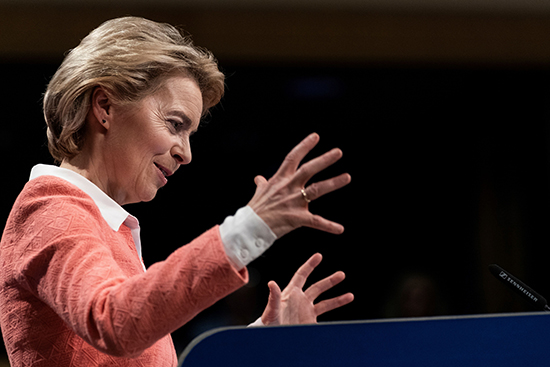夾在貿易爭端和脫歐夾縫之間,歐盟調低2022年前的經濟展望

|
今年11月6日,國際貨幣基金組織警告稱,歐洲需要制定“應急計劃”,避免經濟持續下滑。接下來,歐盟委員會更進一步,自己將歐元區的增長目標一路下調至2021年。 歐盟對2019年的增長預期在年初時還有些樂觀。春天,歐盟經濟持續增長,盡管“步伐穩健”。到了夏天,這種增長“陰云密布”。如今,在發布的秋季報告中,歐盟警告稱,“在高度不確定性的背景下,未來將長期經歷低增長和低通脹”,激烈的貿易爭端、全球經濟放緩和即將到來的英國脫歐的共同影響幾乎波及了經濟的方方面面。 歐盟今年的GDP實際增長率為1.1%(低于去年的1.2%),通貨膨脹率為1.2%。相比之下,美國經濟雖然也在放緩,但預計增長率將為歐盟的兩倍,即2.2%。 對歐洲來說,未來兩年的前景差不多會和今年一樣糟糕,預測2020、2021兩年的GDP增長率仍然為1.2%。通脹在2021年之前不會再次上升達到1.3%,仍然遠低于歐元區設定的接近或高于2%的目標。 歐元兌美元開盤走高,但在歐盟公布調整后的經濟前景展望后,跌至負值。具有諷刺意味的是,即便是疲軟的歐元——報告預測今年歐元將再貶值1%——也無法幫助這個以出口為主的區域擺脫曠日持久的衰退。也就是說,來自建筑、工業生產、金融服務、汽車和零售行業的糟糕數據共同促使歐盟下調財測。 如果你近幾個月來一直關注歐洲債券市場,就會知道,當像德國國債這樣通常十分堅挺的投資產品都出現負值時,一定出現了很嚴重的問題。報告稱:“認為經濟前景將繼續惡化,預測將長期保持非常寬松的貨幣政策,加上期限溢價進一步下降,給主權債券帶來了壓力。” 因此產生了多米諾骨牌效應。隨著投資者涌入市場尋求避險資產,歐洲AAA級國家的收益率開始跌至負值。對這些債券的需求超過了供應,現在“歐洲很大一部分主權債券的收益率為負”。 在其他地方,負利率現象降低了購房者和企業的借貸成本,但不足以刺激投資、刺激消費、促進增長。 這也重創了歐的零售銀行業。對于歐洲最大的幾家銀行而言,低利率和平緩的收益率曲線導致它們尤其難以通過傳統的商業銀行業務——放貸和吸引新客戶——來提高利潤。 西班牙國家銀行(Banco Santander)、德意志銀行(Deutsche Bank)和匯豐銀行(HSBC)今年均已經宣布裁員,以降低成本并度過難關。 歐洲汽車工業的表現也好不到哪去。整個歐盟對新車的需求已經停滯,同時汽車行業開始大舉投資開發電動汽車和自動駕駛汽車。此外,共享汽車和打車軟件的流行遏制了年輕人口中的汽車擁有量。在上述因素的共同作用下,汽車制造業的表現遠低于2015年的水平。 該報告可能會引發一些人呼吁增加財政支出、提振GDP,但迄今為止,德國及其揮金如土的北歐盟友一直斷然拒絕這樣的建議。 但歐盟經濟及金融事務總司長馬可·布提于11月7日在辯論中表達了不同的思路,稱負利率和低利率實際上為歐元區提供了一個通過支出擺脫衰退的特有機會。“非常低甚至負的融資成本為推出具有高社會、高環境、高經濟回報的項目提供了機會。”布提說,“現在應該抓住這個機會。” 該你出招了,德國。(財富中文網) 譯者:Agatha |
On November 6, the International Monetary Fund warned that Europe needed “contingency plans” to avoid a protracted decline. Today, the European Commission itself went one step further, cutting its eurozone growth target all the way through 2021. The EU’s 2019 growth outlook started the year with some optimism. In the spring, it saw continuing growth, though at a “moderate pace.” By the summer, that growth was “clouded.” Now, in the published autumn report, it’s warned of “a protracted period of subdued growth and low inflation in the context of high uncertainty,” as bruising trade wars, a slowing global economy and a looming Brexit have combined to hit nearly every sector of the economy. The EU now sees real GDP growth of 1.1 percent (down from 1.2 percent) and inflation of 1.2 percent this year. In contrast, the U.S. economy, while also slowing, is expected to grow at twice that rate, at 2.2 percent. For Europe, the outlook stays nearly as bad over the next two years with forecasted GDP growth running at 1.2 percent in both 2020 and 2021. Inflation won’t nudge up again until 2021, reaching 1.3 percent, still far below the bloc’s target of closer to 2 percent or higher. The euro, which started the day trading higher against the dollar, fell into negative territory following release of the bloc’s revised outlook. The irony is that not even a weak euro—the report forecasts an additional 1% decline in the value of the common currency this year— can help lift the export-heavy bloc out of its protracted slump. To wit, poor data from construction, industrial production, financial services, automotive and retail sectors all contributed to the decision to lower the outlook. If you were paying attention to Europe’s bond market in recent months you’d have known something was deeply amiss when usually rock-solid investments like German bunds went negative. “The perception of a deteriorating outlook, expectations of a prolonged period of very accommodative monetary policy, and a further decline in the term premium put pressure on sovereign yields,” the report said. That created a domino effect. Europe’s AAA-rated nations started seeing yields fall into negative territory as investors piled into the market seeking safe-haven assets. The demand for these bonds exceeded the supply, and now “a substantial part of sovereign bonds in Europe is trading at negative yields.” Elsewhere, the negative rates phenomenon has sent borrowing costs down for homebuyers and businesses, as well, but not enough to spur investment, consumer spending and boost growth. It’s also clobbering Europe’s retail banking sector. For Europe’s biggest lenders, low interest rates and flattening yield curves are making it exceedingly difficult to grow the bottom line through the traditional commercial banking operations of lending and attracting new accounts. Banco Santander, Deutsche Bank and HSBC have all announced job cuts this year to reduce costs and weather the storm. Europe’s automotive industry hasn’t fared much better. Demand for new cars has stalled across the bloc just as the industry begins a heavy investment into developing electric and more autonomous driving vehicles. Also, the proliferation of car-sharing and ride-hailing apps is depressing car ownership among the younger demographics. Add it up, and car manufacturing is well below 2015 levels. The report is likely to trigger calls for greater fiscal spending to boost GDP growth, a suggestion that so far Germany and its spendthrift northern European allies have rebuffed at every turn. Marco Buti, Director General of Economic and Financial Affairs, took a different tack in the argument on November 7, saying negative and low interest rates actually provides a unique opportunity for the bloc to spend its way out of a downturn. “Very low or negative financing costs provide an opportunity to bring forward projects with a high social, environmental and economic return.” Buti said. “This window of opportunity should be used now.” Your move, Germany. |













